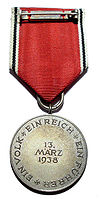Anschluss Medal
| The Anschluss Commemorative Medal Die Medaille zur Erinnerung an den 13. März 1938 | |
|---|---|
  The medal's obverse (left) and reverse (right). | |
| Type | Chest order |
| Eligibility | Military personnel, members of the Austrian branch of the NSDAP, and others |
| Campaign(s) | Interwar period |
| Established | 1 May 1938 |
Ribbon bar of the medal | |
The Anschluss Commemorative Medal (German: Die Medaille zur Erinnerung an den 13. März 1938) was a decoration of Nazi Germany awarded in the interwar period.
Description
Instituted on 1 May 1938, the medal commemorated the annexation of Austria to the German Reich, the so-called Anschluss. The move was the first in Hitler's quest for Lebensraum, and it strengthened German flanks while weakening those of Czechoslovakia. German troops crossed the Austrian border on 12 March 1938, without any resistance. The medal, known as the "Anschluss medal", was awarded to all people, both military and civilian, who contributed to or participated in the annexation. It was also awarded to German State officials and members of the German Wehrmacht and SS who marched into Austria.[2] Last awarded on 31 December 1940, a total of 318,689 medals were given out.[3]
Design
The round, highly detailed, die-struck medal was based on the 1938 Party Day Badge and designed by Professor Richard Klein.[4] On the obverse of the medal, symbolic of becoming part of the German realm, a man holding the Nazi flag stands on a podium bearing the eagle emblem of the "Third Reich"; he assists onto the podium a second man, on whose right hand a broken shackle is seen. On the reverse is the inscription "13. März 1938" (13 March 1938), the date of the Anschluss. The date is surrounded on the outer edge by the words, "Ein Volk, Ein Reich, Ein Führer" ("One People, One Empire, One Leader").[2] It is suspended from a red ribbon with white-black-white stripes at the edges of the ribbon.[5] It was made of brass or tombak bronze with a silvered matte finish.
Notes
- ^ Angolia 1987, p. 56.
- ^ a b Angolia 1987, pp. 55, 56.
- ^ Doehle 1995, p. 61.
- ^ Doehle 1995, p. 60.
- ^ Angolia 1987, p. 55.
References
- Angolia, John (1987). For Führer and Fatherland: Military Awards of the Third Reich. R. James Bender Publishing. ISBN 0-912138-14-9.
{{cite book}}: Invalid|ref=harv(help) - Doehle, Heinrich (1995) [1943]. Medals & Decorations of the Third Reich: Badges, Decorations, Insignia. Reddick Enterprises. ISBN 0962488348.
{{cite book}}: Invalid|ref=harv(help)
